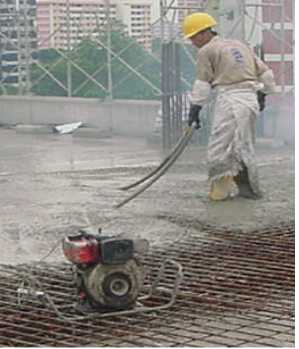Compaction of Concrete
Even if the mixes are well designed and the concrete is properly cured, a low permeability will not be achieved unless the concrete is thoroughly compacted. The object of compaction is to drive out the air entrapped in the concrete during placement, to pack the aggregate particles closely together without causing segregation and to assist in filling the voids between the aggregate and mortar. thorough compaction is particularly important close to corners and edges of concrete members as there are more prone to be attacked by aggressive agents. Extreme care is also required when pouring concrete into formwork with congested reinforcement such as the intersection of beams or a beam column junction. Proper compaction in these areas is often found impractical and improved design should be used to avoid such a need.
All concrete shall be compacted to produce a dense homogeneous mass. It shall be compacted using approved immersion type mechanical vibrators. Sufficient numbers of vibrators in serviceable condition shall be used on the site to compact the concrete at the rate at which it is placed, and a minimum of two standby vibrators shall be readily available for emergency use in case of breakdowns.

Figure 1 Compaction of concrete using vibration machine
The concrete shall be thoroughly worked into all parts of the formwork and between and around the steel reinforcement. It shall be compacted to give a dense and compact concrete, free from voids of any kind. Steel reinforcement shall be prevented from being displaced or deformed during concreting.
References:
[1] Clive Briffett [Edited, 1994], Building Maintenance Technology in Tropical Climates, Singapore University Press.
[2] HDB Specifications